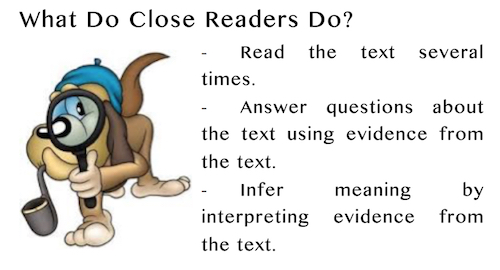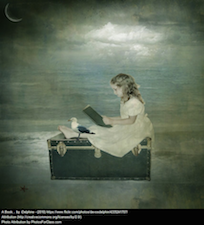4.4 Stopping By Woods On a Snowy Evening
| Site: | Cowichan Valley School District - Moodle |
| Course: | ELA5, CSS, Sferrazza |
| Book: | 4.4 Stopping By Woods On a Snowy Evening |
| Printed by: | Guest user |
| Date: | Tuesday, 6 January 2026, 10:58 PM |
Learning Target
By the end of this lesson, you should be able to say YES to the following questions.
- Can I apply the skill of "close reading"?
- Can I answer questions about the text using evidence from the text?
- Can I find rhyming patterns in a poem?
- Can I determine the meaning of unknown words and figurative language using context clues?

Who Is Robert Frost?
Robert Frost is a famous poet. Before exploring one of his famous poems, let's learn a bit about him. At the end of the video, it is mentioned that Robert Frost thought form was important. You've learned about stanzas and rhyming. These are elements of form that Robert Frost used in his own writing.
Reading Process
Remember, good readers are willing to reread text to dig for evidence. They are willing to do close reading.
1. The first time is often for the "gist" - the big picture, main idea, basic storyline.
2. The second time is often to master the rhythm and rhyme, as well as beginning to build understanding.
3. The third (or beyond) is to delve deeply into understanding the vocabulary and text, and to finding evidence to support ideas and respond to questions.

First Reading
As you read "Stopping By Woods On a Snowy Evening" by Robert Frost the first time, try to understand the "gist" (a sense of what the poem is about and a sense of how it may be read) of the poem.
Stopping by Woods on a Snowy Evening
Whose woods these are I think I know.
His house is in the village though;
He will not see me stopping here
To watch his woods fill up with snow.
My little horse must think it queer
To stop without a farmhouse near
Between the woods and frozen lake
The darkest evening of the year.
He gives his harness bells a shake
To ask if there is some mistake.
The only other sound’s the sweep
Of easy wind and downy flake.
The woods are lovely, dark and deep,
But I have promises to keep,
And miles to go before I sleep,
And miles to go before I sleep.
Robert Frost, “Stopping by Woods on a Snowy Evening” from The Poetry of Robert Frost, edited by Edward Connery Lathem. Copyright 1923
Read Along - Second Reading
Listen and read along - you'll find a copy of the poem in your Learning Guide. The rhythm and rhyme of the poem make it easier to read.
In Your Learning Guide

In your Learning Guide, answer questions 1, 2, and 3 for this lesson. Then, return to this online lesson book.
Closer Reading
Now, it is time to do a "Close Reading". You will be responding to some questions that can be answered using evidence from the text itself. What does this look like? Here is an example of instructions, a question, and an answer.
Instructions: Read the first two stanzas of “Stopping by Woods on a Snowy Evening” aloud.
Question: What is the setting of the poem? How can you tell?
Answer:
The setting is snowy woods in the winter in the evening. The evidence that supports this is:
“Whose woods these are …” shows that they are in the woods.
“Woods fill up with snow…” shows that it is winter in the woods.
“Between the woods and frozen lake” also indicates it is likely winter.
More evidence that supports winter is—“The darkest evening of the year.” The longest and therefore darkest night of the year is around December 21st.
This is a very strong answer as it has specific evidence from the poem explained.
Turn to your Learning Guide to do some close reading and responses using evidence from the text. After completing $4 - #7, you will be directed back to this online lesson.

Read Aloud Practice
Practice reading Stopping By Woods On a Snowy Evening aloud. Here are some goals for your read aloud:
-
-
- Expression and Volume - Adjust your volume and tone of voice to show emotion and/or mood.
- Clarity and Enunciation - Speak (articulate) clearly, with good pronunciation so each word can be understood.
- Pace / Fluency – Speak smoothly and fluently, with few hesitations.
-
When you are feeling confident, read the poem aloud to your home facilitator. Talk together about what you did well and what you could improve upon.
Music and Poetry
You've worked hard on your "close reading", learning how to support your ideas using evidence from the text, and reading poetry aloud. Let's complete this lesson with some enjoyable music! Be sure to listen to both versions below.
This poem is so famous it has even been turned into music! Any song with lyrics is really poetry that is being sung. Here, the famous male choir from Vancouver, Chor Leoni, is singing the poem. This choir has been around since 1992 and even has several CDs available. Some of their songs are serious and some are really fun. This is a "serious" song. Can you hear and imagine the horse stopping in the woods? Can you picture the snow gently falling in the quiet? Listen to a couple minutes - more if you like.
Here is a less "formal" version of the poem put to music. It is amazing how one poem can be presented so differently through music. Enjoy!
Reminder
In the next day or two, read some poems independently. Then, add to your poetry reading journal to show your independent reading reflections.
